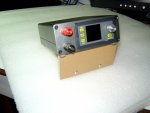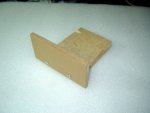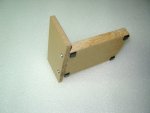- Joined
- Sep 20, 2008
- Messages
- 17,635
- Points
- 113
We've been looking for an adjustable Lab Laser Diode Power
supply for quite some time now. We already have a commercial
Opto Power Corp OPC4005 40 Amp adjustable Laser Diode supply
that we use for Coating testing and LaserBee LPM calibrations.
That supply measures about 18" X 14" X 3.5" and weigh quite a
bit. We have looked at the eBay/AliExpress CV/CC power supplies
but don't like/trust their output noise/spikes.
Recently I've come across an EEVblog Y/T video of a small CV/CC
PS from an AliExpress seller and decided to get one of his other
PS models.
I decided on the DPH3205.
https://www.aliexpress.com/item/RD-...32762131242.html?spm=a2g0s.9042311.0.0.nTIpxS

This is a 32 Volt 5 Amp Constant Voltage/Constant Current PS
that has a small color LCD display with tactile control buttons
and a rotary selection control knob.
There is a Setup menu that you can set the Over Voltage
Protection as well as the Over Current Protection. That is
what I found very useful and is included in our much more
expensive OPC4005 PS.
I chose this model because the LCD display shows 1mA resolution
You also have an option to get the metal case designed for the
PS. I highly recommend buying it.
https://www.aliexpress.com/item/RD-...32794029335.html?spm=a2g0s.9042311.0.0.nTIpxS

The only thing I didn't like about it mechanically was that it did
not have a tilt handle to tilt the display up from flat on the work
bench. I designed a simple solution that anyone can easily build.
[See Attached Pic below]
Once it was assembled I decided to test the electrical specs
and check for hidden spikes while adjusting the Voltages and
currents on a Digital Storage scope. I attached a Dummy Load
to the output and scoped the Sense Resistor.
Depending on how clean the input supply to the PS is depends
a lot on the noise of the output. I typically get about 70mV to
100mV zero line noise.
Turning the supply output ON and Off from the On/Off button
on the Display panel showed no spikes at all or at least I didn't
detect any with a one shot scope detection.
Incrementing the current by 1mA steps showed a clean step
every time without and spiking.
Incrementing the current by 100mA steps again showed no
detectasble spiking on the scope.
To say the least... I'm very impressed with this extremely small
physical size of this CV/CC Power Supply and would recommend
it to anyone that wants an adjustable Lab style Laser Diode PS
And you can't beat the ridiculously low price for the quality
and specs....IMO
We ordered one of there new PS and are waiting on its arrival.
This model is similar to the one we tested but also includes
USB and/or Bluetooth connections to a computer with free
Win7 or later Software.
Jerry
supply for quite some time now. We already have a commercial
Opto Power Corp OPC4005 40 Amp adjustable Laser Diode supply
that we use for Coating testing and LaserBee LPM calibrations.
That supply measures about 18" X 14" X 3.5" and weigh quite a
bit. We have looked at the eBay/AliExpress CV/CC power supplies
but don't like/trust their output noise/spikes.
Recently I've come across an EEVblog Y/T video of a small CV/CC
PS from an AliExpress seller and decided to get one of his other
PS models.
I decided on the DPH3205.
https://www.aliexpress.com/item/RD-...32762131242.html?spm=a2g0s.9042311.0.0.nTIpxS

This is a 32 Volt 5 Amp Constant Voltage/Constant Current PS
that has a small color LCD display with tactile control buttons
and a rotary selection control knob.
There is a Setup menu that you can set the Over Voltage
Protection as well as the Over Current Protection. That is
what I found very useful and is included in our much more
expensive OPC4005 PS.
I chose this model because the LCD display shows 1mA resolution
You also have an option to get the metal case designed for the
PS. I highly recommend buying it.
https://www.aliexpress.com/item/RD-...32794029335.html?spm=a2g0s.9042311.0.0.nTIpxS

The only thing I didn't like about it mechanically was that it did
not have a tilt handle to tilt the display up from flat on the work
bench. I designed a simple solution that anyone can easily build.
[See Attached Pic below]
Once it was assembled I decided to test the electrical specs
and check for hidden spikes while adjusting the Voltages and
currents on a Digital Storage scope. I attached a Dummy Load
to the output and scoped the Sense Resistor.
Depending on how clean the input supply to the PS is depends
a lot on the noise of the output. I typically get about 70mV to
100mV zero line noise.
Turning the supply output ON and Off from the On/Off button
on the Display panel showed no spikes at all or at least I didn't
detect any with a one shot scope detection.
Incrementing the current by 1mA steps showed a clean step
every time without and spiking.
Incrementing the current by 100mA steps again showed no
detectasble spiking on the scope.
To say the least... I'm very impressed with this extremely small
physical size of this CV/CC Power Supply and would recommend
it to anyone that wants an adjustable Lab style Laser Diode PS
And you can't beat the ridiculously low price for the quality
and specs....IMO
We ordered one of there new PS and are waiting on its arrival.
This model is similar to the one we tested but also includes
USB and/or Bluetooth connections to a computer with free
Win7 or later Software.
Jerry







